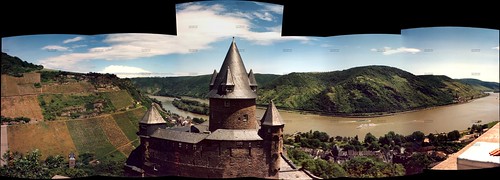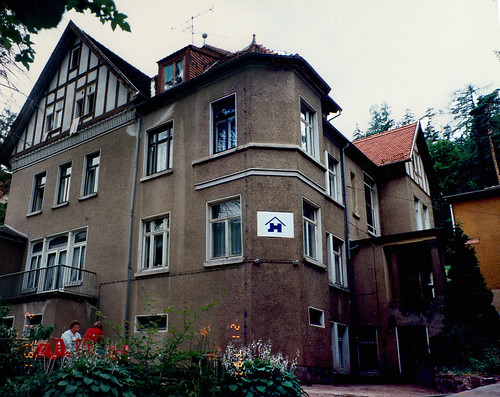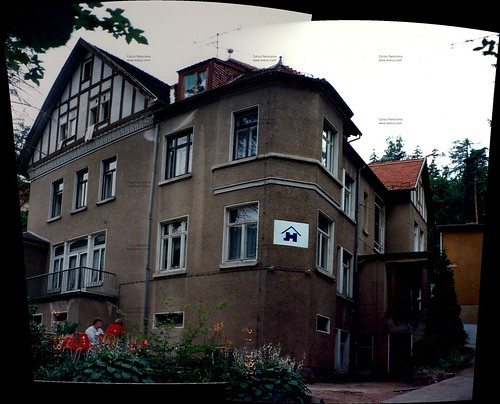Panoramic photography is something I’ve been playing with for years — long enough that Prairie was amused to see that I was taking multi-shot panoramics back when I visited Europe during my high school years, long before I had any way to assemble them together with anything more sophisticated than scissors and tape.
Unfortunately, the state of panoramic software on the Mac has been less than I’d like for quite some time now. Apple’s excellent Quicktime VR Authoring Studio is long out of date, without any sign of it being updated for OS X (in fact, searching for it on Apple’s site only returns references to it, with no official product page listed). Canon’s Photostitch is used fairly frequently, but I’ve never been that thrilled with it. Functional, but it doesn’t really “feel” like a true OS X application, and it doesn’t allow for much tweaking or fine-tuning. Other Mac OS X panoramic tools are either commercial and expensive, or command-line ports that I’ve never taken the time to investigate fully (such as Panorama Tools). For a time when I had a working PC I used The Panorama Factory and was quite happy with its range of options, but since my PC finally gave up the ghost, TPF’s performance under Virtual PC wasn’t good enough for me to continue using it.
For the past year or so, though, I’ve been keeping an eye out on AutoStitch. It looked to be the “holy grail” of panoramic creation software: originally created as a research project at the University of British Columbia, it produces truly automatic panoramic photos, stitched from multiple photos that don’t even have to be aligned or all taken with the same exposure (a 57-shot example is shown on the AutoStitch page). The problem, of course, was that AutoStitch is PC-only. Still, I kept seeing incredible panoramas that AutoStitch had produced, so I’d occasionally check in to see if a Mac OS X port had popped up yet.
This morning, my persistence paid off. I’m not sure when it first appeared, but Kekus Digital has produced a pseudo-port of AutoStitch for Mac OS X (licensing the AutoStitch technology in a Mac OS X package) called Calico.
I’ve just spent a few minutes playing with it, and I’m extremely impressed. It really is as easy as I’d heard: pick your photos, drop them on, and a few minutes later you have the final panoramic image.
For example, this is a panoramic stitch of six shots produced with Apple’s Quicktime VR Authoring Studio (running under the Classic emulation layer in OS X). Because QVRAS doesn’t support exposure correction (and I didn’t attempt to manually correct the images in Photoshop), the final image shows very obvious banding, and there are numerous points in the ‘seams’ where lines suddenly shift or don’t merge correctly (most obvious if you download the 4Mb large version and view it at 100%).
Compare that to the version produced by Calico (here’s the 4.3MB large version):
It’s not flawless (but then, these are scans of 15-year old photos taken with a point-and-shoot film camera), but it is far better than the QTVRAS version. I was able to use all seven shots I took (the seventh being one of the central tower, raised above the plane of the other six shots), Calico is able to perform automatic exposure correction (still slightly visible at the seams, but not nearly as jarring as in the uncorrected version), and there is much less visible distortion along the seams.
For a second test, I used a two-shot panoramic image that QTVRAS hadn’t even been able to handle — no matter how much I tweaked the settings or manually rotated and aligned the images before telling it to stitch, QTVRAS couldn’t create a useable final image. Eventually, I took the images into Photoshop and created the following image by hand.
Honestly, I don’t think I did too badly — it just wasn’t exactly a simple process. I had to pull both shots into Photoshop, increase the canvas size of the left hand shot to a point where I could drag the right hand shot in, manually rotate and distort the right hand shot until it (mostly) lined up, use a layer mask to blend the two images into each other, then try to color correct the two layers so that they looked similar. It came out pretty well (and far better than QTVRAS could do)…it was just time-consuming.
With Calico I dragged the photos onto the program, hit ‘Align’, verified that the program had assembled the shots together correctly (it had), hit ‘Make’, waited a few minutes…and got this:
Not bad…not bad at all. The proportions of the building look a bit better, though the sky blending is a bit obvious (to some extent, a limitation of only having two photos with very different exposures to work from).
Those watermarks you see on the Calico-produced images will be disappearing soon, as I have no issues at all with the $29.95 registration fee for this. I’ve been waiting for software like this for a long time, and it’s good to finally have it available.
![]()
“Casbah” by Switch Flick from the album Essential Chillout (2000, 7:13).





Impressive. More so than the Panorama helper mode in my Nikon 5400.
I may have to take a look at this.
Nice program! If you have an Mactel, you may want to try Bootcamp and check out the PC only apps that would compete with this, and let us know the results.
No Mactel for me — “just” a dual 2.0ghz G5 PowerMac — so I can’t play with dual-booting WinXP. I’m okay with that, though…the only reason I even have VirtualPC on my machine is to run the software for my math class. I’m quite happy not having to deal with Windows at all. :)
Thanks for the kind words about Calico!!! I always search the web for interesting sites mentioning my programs. :)
I, like you, have been searching for a Mac port of Autostitch, and I found your page as the sixth hit down on a Google search for “autostitch mac”. Hooray! I will be checking out Calico promptly! :)
I’ve played around with Photoshop CS2’s Photomerge, Arcsoft Panorama Maker (came free with a scanner), LM Stitch, and a bunch of others. Recently I’ve discovered Calico and was a little leary of a “fully-automated” panorama software, but this program beats them all. I’ve never seen results like this from a $40 program. My only complaint is that they use Share-It as their transaction processor and they’re the only processor I’ve ever had trouble with.
great post! this really helped me a lot! i was using canons photostitch, which was never really my choice but i stuck to it for it was simple and easy to use for the casual photographer. but it isn’t compatible with snow leopard so i was searching for the best/simplest panorama tool for mac… found it through your post :) i don’t mind buying calico for 30 bucks, it is really a GREAT pice of software!
for those that have windows on their macs (bootcamp or parallels or whatever) there’s a free microsoft (!) app called ICE that does it beautifully . It’s at http://research.microsoft.com/en-us/um/redmond/groups/ivm/ICE/
For hobby
This software has the same function as the one they have in some Nokia Phones, the only difference is it is used for the camera, so the software works simultaneously with the camera to take panoramic images even 360 degrees
If you have an Mactel, you may want to try Bootcamp and check out the PC only apps that would compete with this, and let us know the results.This software has the same function as the one they have in some Nokia Phones, the only difference is it is used for the camera, so the software works simultaneously with the camera to take panoramic images even 360 degrees. Anyway, thanks for sharing.